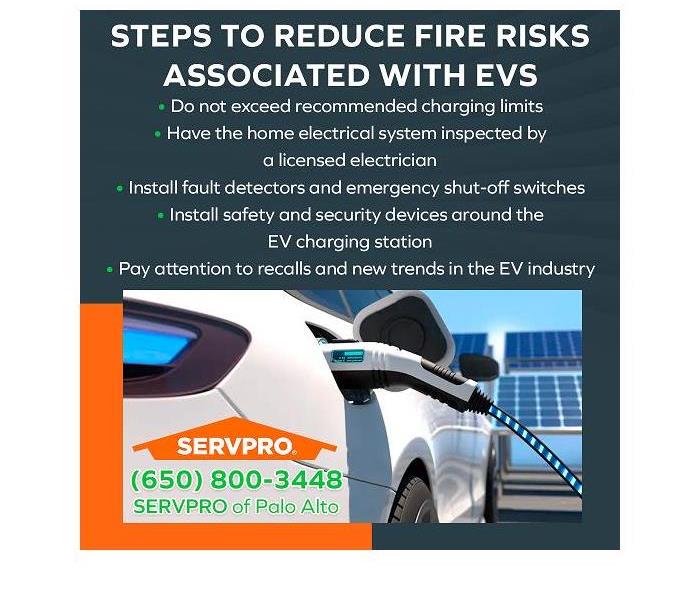What are the fire damage risks from EV home recharging stations?
3/16/2023 (Permalink)
Blog Summary: SERVPRO of Palo Alto offers tips on how to decrease the risk of house fires caused by the charging of electric vehicles.
SERVPRO® of Palo Alto is a leader in providing fire damage, smoke, damage, and water damage restoration services to Palo Alto and Bay area residents and businesses.
The risk of fire from charging an EV
The number of electric vehicles (EVs) is growing. The US EV market in the United States topped 6.7% by mid-summer 2022. In 2019, EVs made up just under 2% of vehicles on the road. Of the nearly 1.45 million EVs registered in the US, California boasts over 563,000 units, a 38.7% share of the EV fleet in the United States.
As with the growth of any new industry, challenges arise. Some EV owners are anxious that their EVs may create a significant fire hazard while charging at home. These fears are not groundless. Over the past few years, several major carmakers have issued recalls for some of their EVs due to fire risks.
Jane Marsh, a specialist in climate policy, sustainability, and renewable energy, comments on the house fire risks from EV charging: “While EVs may not have tanks full of combustible liquid like conventional cars, their batteries pose fire hazards. The lithium-ion batteries that power these vehicles have a high energy density and use flammable components. As a result, if something goes wrong, they could catch fire quickly and burn extremely hot. These hazards are a concern in all lithium-ion battery products, not just EVs. The Consumer Product Safety Commission reported more than 25,000 overheating and fire incidents from 400 types of products using these batteries over a five-year period.”
Marsh elaborates on the specific housefire risks of charging EVs at home, stating, “Charging EVs at home, especially overnight, past their full capacity could cause overheating, leading to fires. Battery damage or electrical issues could heighten these risks. As automakers like GM aim to eliminate gas vehicle sales by 2035 and EV adoption grows, this fire hazard becomes more concerning.”
Are fires from EVs a frequent occurrence?
Incidents of EVs catching fire are not a common occurrence. In fact, EV fires are rare. Research indicates that EVs experience approximately two dozen fires for every 100,000 vehicles, while traditional fossil-fuel-based vehicles account for 1,500 fires. Manufacturer recalls of gasoline-powered cars for fire hazards significantly outnumber recalls of EVs for the same reason.
The probability of an EV causing a fire while charging at home is very low compared to home appliances such as electric stoves. Cooking accounts for roughly 474 home structure fires each day. Electric stovetops far outnumber EVs, but housefires caused by EVs are relatively lower by comparison.
Although rare, a house fire from charging an EV is still difficult to extinguish. With the increase in the number of EVs comes a greater likelihood of more fires. The practical steps listed below will reduce fire risks associated with EVs.
Step #1: Do not exceed recommended charging limits
Overcharging an EV’s battery is one of the leading causes of fire. Charging the battery to less than 100% will ensure the battery does not overheat. Fire experts advise EV owners to avoid charging their EVs overnight. If an EV needs repair, do not park it in the garage. Instead, park the car a safe distance from the house until the problems are diagnosed, and the repairs are completed.
Step #2: Have the home electrical system inspected by a licensed electrician familiar with adapting the home wiring system to accommodate an EV charger
Homeowners should have an electrician inspect their wiring before installing EV chargers to ensure they can handle the high voltages necessary to charge the vehicle. Older homes and damaged systems may be unable to charge EVs safely.
Step #3: Install fault detectors and emergency shut-off switches in electrical systems
Keep all equipment in optimal operating condition. Low fire risk, peace of mind, and uninterrupted service are the benefits of proper maintenance.
Step #4: Install safety and security devices around the EV charging station
A smoke detector can sound the alarm in case a fire occurs when the EV is charging. Keep an appropriate fire extinguisher handy in case a fire incident occurs. Never spray water on a burning EV. Immediately contact fire first responders. Keep a safe distance from the EV. Lithium-ion batteries generate intense heat and toxic fumes.
Install a discrete remote video camera for both personal safety and security purposes. The camera will allow real-time viewing of a fire incident from beginning to end, and this information could help determine the cause and nature of the fire.
Step #5: Pay attention to recalls and new trends in the EV industry
EVs and battery technology are in their infancy. As bugs are discovered and resolved, the EV owner must stay informed about new issues and new advances in relevant technology.
What to do if an EV charging fire breaks out
Once the smoke or flames are discovered, follow all safety precautions and fire suppression procedures recommended by the manufacturer. If possible, shut off the power to the charging station. Call 911.
If fire damage, smoke damage, and water damage cleanup and restoration are needed, call the trained, IICRC-certified professionals at SERVPRO of Palo Alto for assistance. The team is trained to safely clean up and restore any hazardous fire and smoke damage disaster. Crews are available 24/7, 365 days a year, including holidays.
For more information about water damage restoration in and around Linda Vista Park, Cupertino, CA, and the surrounding area, email SERVPRO of Palo Alto at office@SERVPROpaloalto.com or call (650) 800-3448.



 24/7 Emergency Service
24/7 Emergency Service
